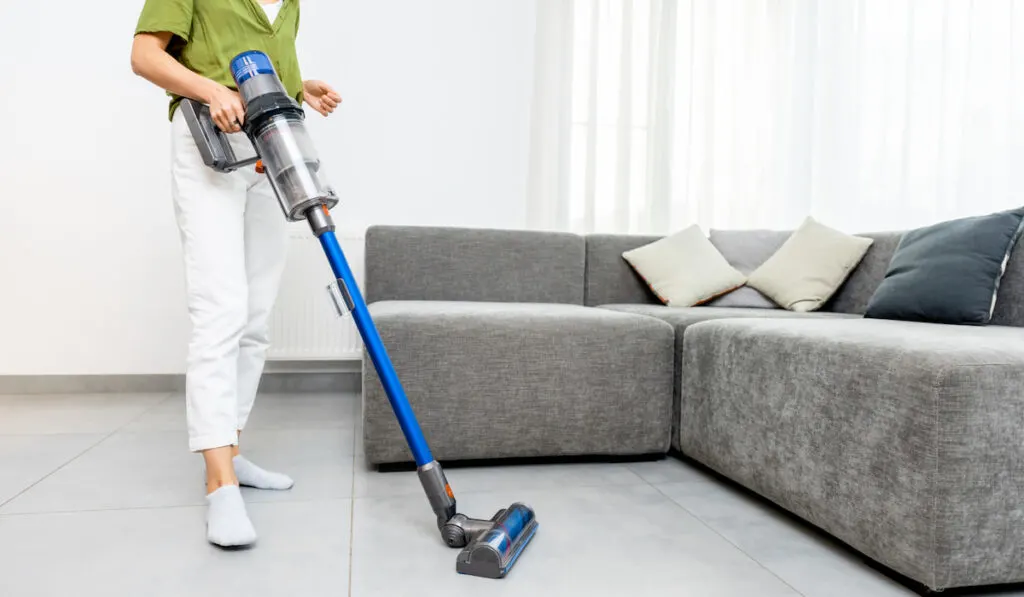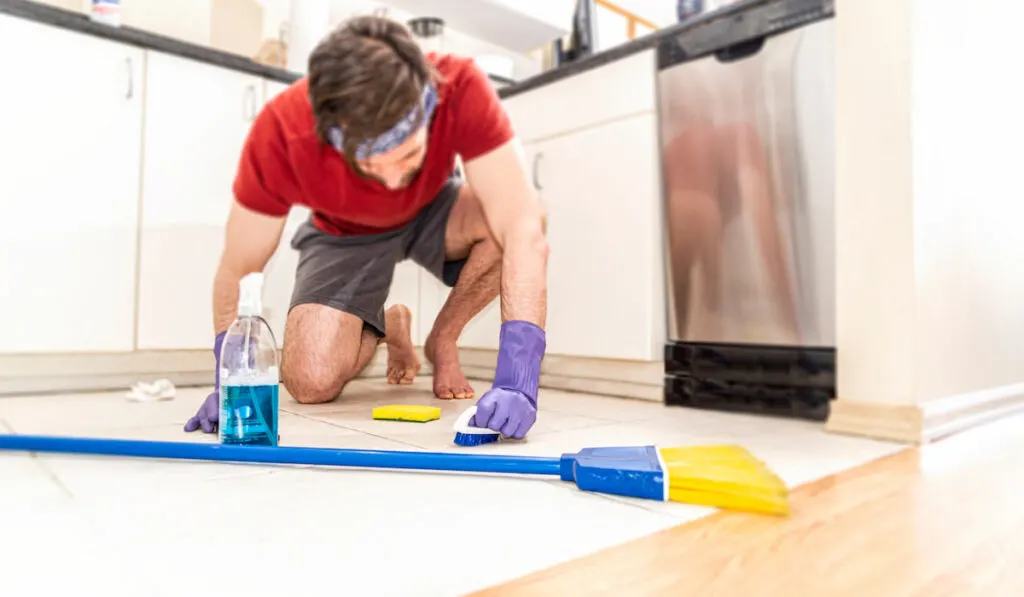When cleaning a room it is easy to overlook the corners and edges of the floor. While getting into these spots usually requires a different approach than a simple vacuum or mop, the process is still easy. Keeping up on this can save you time and effort in the long run by preventing build-up.
To clean corners and edges on carpet and tile you should:
- Start with a clean workspace
- Vacuum the corners and edges
- Use a rag or brush to dislodge any debris
- Vacuum the debris
- Pass over the area once more

This same process can apply to both carpet and tile with only a few variations between the two.
Keep reading to learn how you can keep the corners and edges of your rooms looking nice and clean.
Table of Contents
How to Clean Carpet Corners and Edges
When cleaning carpet corners and edges you want to start by cleaning the whole room. Make sure you dust before to prevent these particles from settling as or after you clean. Then vacuum the entire carpet. Using a powerful brush roll vacuum will help get up as much as possible without requiring many passes.
Starting with a clean workspace is essential to ensuring that dirt, dust, and debris (and possibly fur) do not make their way into the area you are focusing on. Keeping up a practice of cleaning like this regularly can also limit the amount of work you need to do to the edges by limiting what can pile up and get pushed outward.
Use a Crevice Attachment to Vacuum the Area
If your vacuum has a crevice attachment you can use that to work into the area alongside baseboards. If not, you can look for one that is fitted for your device or try to find a universal kit compatible with your vacuum. Handheld vacuums are also useful, but you can start off using just the hose if needed.
Push the crevice tool or vacuum hose into the carpet to suck up anything hiding in there. Make sure you work back and forth, passing over the area at least two or three times in each direction to pick up as much as possible.
This is something you should do with your weekly vacuuming routine or before deep cleaning in these areas.
Work the Dirt, Dust, and Debris Free
Using a scrub brush , grout tool , or an old toothbrush, scrub at any areas on the edges or corners of the carpet that appear dirty. This will help you further dislodge any dust or sediments that have built up in this area.
While you are doing this, take care not to scrub too roughly against the baseboard. This can damage the paint and even the wood, so proceed cautiously.
When you feel you have managed to loosen as much as possible, go over the area with the crevice tool or vacuum hose again to pick up anything you have knocked loose. The area should start to look better at this point, but there is still more you can do.

Treat Stains with Carpet Cleaning Solution
Any areas that are visibly soiled, whether through dirt or spills, can benefit from a carpet cleaning spray. Look for products that are neutralized alkaline or acidic based to use on your carpet. You can also DIY your own carpet spray using a 1:1 solution of white vinegar and water.
If the area is wet from a spill make sure you blot up any excess fluid before you treat the area.
Spray the cleaner on the area, and then look to the instructions for how long you should let it sit. Some cleaners allow you to dab it up immediately, while others want you to cover it and wait fifteen minutes.
If the soiled area has dirt then you can use the brush again here to further dislodge the debris. Work the cleaner into the area while it is still damp. You can use a wet-capable vacuum or a white cloth to pick it up. This is usually the turning point for stubborn messes.
Finish by running the vacuum over the dry area for a few more passes.
Dealing with Persistent Dirt
Persistent dirt or stains may warrant a professional visit, but you can try using or renting a carpet cleaning machine in the area. Start with a freshly vacuumed area, spray a cleaner compatible with your machine, and then use the hose attachment on the edges.
Make sure you work slowly and pass over the area at least two or three times for the best chance at eradicating the mess.
How to Clean Tile Corners and Edges

When cleaning tile corners and edges make sure you start with a clean work area. Start by vacuuming the area to remove as much loose dirt as possible. You can also sweep or use a dry mop to pick up extra dirt, dust, or fur.
Make sure you use a crevice tool to reach under cabinets and appliances along the edge of the room.
Use a mop to clean the tile of the room. Make sure you work on one area at a time and rinse the pad as needed to prevent depositing dirt back onto the floor.
Once the area is clean you can proceed to the corners and edges.
Use a Grout Brush on Corners and Edges

Keeping the corners and edges of tile clean can help you avoid hours scrubbing at the area.
Dip your grout brush in the cleaning solution you used to mop and use that to scrub any dirt in the corners and edges of your tile.
If you are working along the baseboard you should test the cleaner and brush to make sure they are not too abrasive for the paint or the baseboard material.
When you have used the brush to scrub along the corners and edges, use a soft microfiber cloth to soak up the cleaner. The cloth should also help pick up any debris that has been knocked loose, and you can repeat the process as needed.
When you are done cleaning the edge of the tile, pass over once more with the mop to ensure the cleanliness of the area.
Final Thoughts
While cleaning up the corners and edges of the room can add to your regular routine, spending a few minutes on these areas can prevent built-up dirt and debris. It is much easier to run a vacuum, mop, or cloth over the area than it is to spend time and energy scrubbing.
